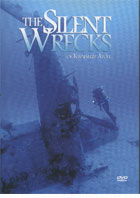
The Silent Wrecks of Kwajalein Atoll 2004; DVD released 2006
Distributed by Janson Media, 88 Semmons Road, Harrington Park, NJ 07640; 201-784-8488
Produced by Jonathan Bird and Art Cohen
Director n/a
DVD, color, 71 min.
College - Adult
History, Military Studies, World War II
Date Entered: 01/09/2007
Reviewed by Jeremy Linden, Head of Archives and Special Collections, Daniel A. Reed Library, State University of New York College at Fredonia, Fredonia, NYThe Silent Wrecks of Kwajalein Atoll introduces the viewer to an undersea world of ships and aircraft slowly corroding in the lagoon where they were sunk nearly 60 years before. A tour, not only of the wrecks, but of the vibrant underwater world they now support, the goal of the Oceanic Research Group seemingly goes far beyond their stated desire to document these lost tools of war; rather, their presentation successfully places these ships and aircraft in a larger continuum, one which ranges from business, war, and death, to today’s historical perspective and continued life. The result is an examination which, while weak in its presentation of any single point, exudes strength in the wealth of exposure it provides to seldom dealt-with topics.
Though it concentrates on the wrecks of the Kwajalein lagoon, this historical documentary lends a voice not only to the silent wrecks but to the silent history of military conscription, abandoned equipment, and Kwajalein’s continued relationship to its past. Unlike the Pacific Ghosts project and other efforts to trace lost aircraft and shipwrecks, the Kwajalein wrecks have been known about but inaccessible, both physically and intellectually. These are not the remains of battleships and destroyers, of a sea battle which captures the imagination, but the wrecks of Japanese supply and transport ships, many of which were conscripted merchant ships forced into military service, sunk by American aircraft attacks while they were still in the lagoon. The variety of American aircraft were not shot down in battle, but abandoned after the war, deemed too damaged to repair and use again. The results are clusters of artificial habitat created long before the creation of reefs by sinking retired ships was an acceptable practice. The wreck of the Prinz Eugen, a German Hipper-class cruiser, was not a casualty of war, but capsized at Kwajalein after surviving two American atomic bomb tests. The present-day atoll is not a South Pacific tourist destination, but a highly secured American military installation, open only to those with proper security clearance – part of the reason the wrecks have not been accessible until now. Kwajalein and this documentary serve as a contradiction to popular presentations of the history of the Pacific War. The battle is there, its significance is discussed, but brought to the forefront are the details of warfare that are often lost in the recounting of battles and assaults.
A combination of dive footage, surface documentary of present-day Kwajalein Atoll, archival footage, and interviews, including one of Richard Sorenson, a Congressional Medal of Honor recipient for his actions at the Battle of Kwajalein, this documentary is highly recommended for its presentation of a story which goes far beyond the invasion of a Pacific atoll in January 1944. Also included on the DVD are Making of a Battle, a 15 minute U.S. military World War II propaganda film documenting the Battle of Kwajalein, the Director’s commentary, stills of the production, and biographies of the crew. Please note that this programming, particularly Making of a Battle, does contain graphic content.